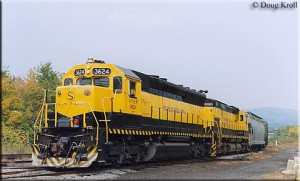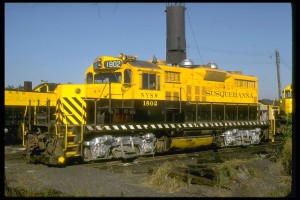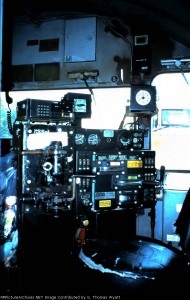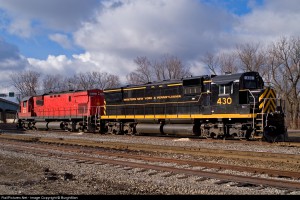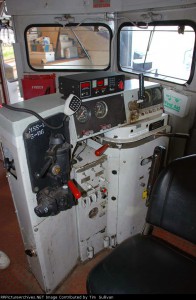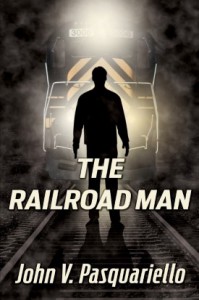If you’ve read the novel, you have been exposed to these terms. These are the principle locomotive types that play important and in one case, a dominant role in the story. They hold the same status as characters in the story. But many of you have no idea just what these things look like, or have any idea on how to visualize them in your mind. Well, here’s a quick primer.
PARTIAL PLOT SPOILER AHEAD! When the scene about the disabled train that has to get moved out of the way unfolds, I identify the lead unit as an EMD SD 45. This was a large, very attractive locomotive designed in 1966 by the Electro-Motive Division of General Motors (EMD). With 3600 horsepower, it was the most powerful commercially available locomotive made at the time. What set it apart from its more common, lower horsepowered SD 40 was its flared radiator section at the rear. SD was a designation by EMD that meant the unit was designated for “Special Duty,” meaning it was a road locomotive with six powered axles that could both lug heavy loads and power higher speed through freight trains with equal reliability, but not really suitable for switching. The 45 was simply a model number and had no bearing on its horsepower. It looked like this example from the NYSW Railroad:
The locomotive that comes to the rescue of the train is a GP 18. Again built by Electro-Motive Division, this smaller locomotive was first built in 1960 and was designed for “General Purpose” switching and road freight work. It only had four powered axles and could do almost any job a railroad could throw at it, hence the term, General Purpose (GP) The unit only produced 1800 horsepower, so EMD used that to give the model its designation as a GP 18. It had a very nice design to it, too, with a sloped front nose, round cab roof and a very wide front windshield. Again, here’s an example from the NYSW of their locomotive number 1802:
And here’s its control stand where a lot of action takes place at in the story:
The third locomotive in the story is the “Rock Star,” the locomotive that plays perhaps as important a role in the novel as any main character. It is the locomotive that so much of the action centers around and takes place on right to the climactic scenes of the novel. It is the ALCO C-430. ALCO is the acronym for the American Locomotive Company, a very old line company that can trace its beginnings to the very dawn of railroading in this country. In 1901, a number of smaller early locomotive companies consolidated into the modern American Locomotive Company and produced steam locomotives from then until just after World War 2. Starting at the turn of the 20th Century, ALCO, as it became known, began dabbling in diesel locomotives, producing a number of pioneering “Boxcab” designs that literally looked like a big box with windows on either end for the engineer to see where he was going. Over time, ALCO developed better and better locomotives and even pioneered the design of what is known as the “Roadswitcher” type locomotive. These are the type you see today on railroads all over North America: a narrow front and rear hood with a cab that extends to the edge of the frame with a handrail-bounded running board on each side of the narrow hoods. Just look at the two examples I showed you above and you’ll see what I’m talking about.
Over the years, ALCO simply could not keep pace with EMD. They were a small company fighting what was at the time the largest corporation on earth. And unlike the movies, in this case, the little guy had no chance. In 1969, ALCO exited the locomotive business. Their Canadian subsidiary, Montreal Locomotive Works, continued producing ALCO designed locomotives in Canada until the early 1980’s, by then becoming a subsidiary of Bombardier Corporation.
In the mid-1960’s, in their last ditch effort to compete with EMD, ALCO began building their “Century” series of locomotives. Thus from that time on, their locomotives all carried the “C” before their model number. They produced both four and six powered axled locomotives of varying horsepower, ranging from 1500 to 3600. The apex for their four axle Century types was the C-430 (four axles, three thousand horsepower). It was a very attractively designed locomotive that was supposed to do almost anything a railroad could dish up, from switching yards, to drilling cars in and out of industrial spurs to racing across country at the head end of a high speed manifest or intermodal freight train. Unfortunately, it never caught on. Only 16 were ever built, and today just 5 remain, of which only 3 are in daily service, one stored awaiting repairs, and one stuffed and mounted in a museum. Here is what the locomotive in my novel looks like, right down to its near-correct paint scheme:
And here is its control stand, again the center of much of the action in the latter parts of the story:
Number 430 on the Western New York And Pennsylvania Railroad IS the 3006. Just use your imagination and renumber the unit and re-letter it for the Midland. Better yet, here’s a rendition I did a few months ago:
The thing about Number 430 is that it was the NYSW’s Number 3000 until it was sold to the WNY&P. It’s sister locomotive, the 3006, is the unit that is currently awaiting repairs on the WNY&P. Now look at the other two examples and you’ll also see they came from the NYSW railroad. Do you see a pattern developing here? Good, because that’s what my next blog is going to be about.
Now you know what these “Characters” look like. I only hope that one day, I can show you what Laura, Mike, Todd, Carlos and Rosario, the five principle characters in my novel, will look like. Then again, one never knows, do one?
Thanks to contributors on the internet and on rrpicturesarchive.net for their photos.
